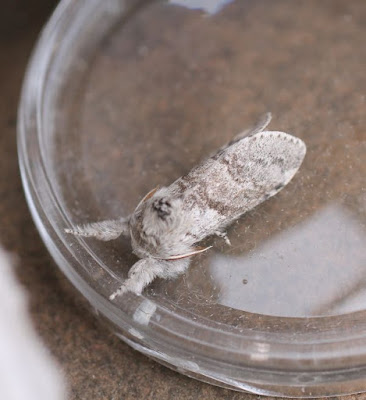1 June 2019
1 June 2019 – Twenty-plume Moth
 |
| Twenty-plume Moth (Alucita hexadactyla) |
Apologies for the murky image of the Twenty-plume Moth (Alucita hexadactyla). My excuse is that I had to photograph it in a plastic tube as it is almost constantly in motion – little darting runs, one after another and no settling down into a resting position.This is only the third recorded at Shandy Hall, the last sighting being in August 2013, even though it flies throughout most of the year. Here is a link to the naming of the insect.
 |
| Tinea trinotella |
Tinea trinotella
has a gnawing larval stage – hence the Tinea (‘gnawing worm’) part of the binomial. The larva feeds on honeysuckle by making a small hole in the unopened bud and then taking up residence inside the vegetable envelope where it will stay, changing colour from yellow to red and then finally pupate.
 |
| Pale Tussock (Calliteara pudibunda)
|
The Pale Tussock rests in a characteristic way with both fore-legs thrust out in front of the head and with its orange antennae sweeping back. It is a dynamic and attractive moth that has a scientific name reflecting the fact that it is a beautiful (kallos – greek for beauty) insect arriving in (ear) the Spring. Pudibundus means modest; but it can also mean the opposite ie immodest or disgraceful with legs thrust forward in a rather shameless way. The fact that this is the male of the species adds even more mystery to Linnaeus’s naming of the moth.
 |
| (Aethes smeethmanniana) |
This choice of only four species represents a better night for trapping. A warmer evening encouraged the following list of moths to take flight : Buff-tip, Single-dotted Wave, Green Carpet, Silver-ground Carpet, Poplar Hawk-moth, Elephant Hawk-moth, Common Pug, Brimstone, Buff Ermine, White Ermine, Heart and Dart, Common Swift and Aethes smeethmanniana.
The last moth in the list was described by Bowen Chang (UPenn intern) a few years ago. Follow this link to learn more.
National Gardens Scheme evening opening at Shandy Hall for moth trapping this coming Friday.
Recent Moths
- 25 July 2023 – Collective Noun for Hawkmoths
- MOTH LIST to August 2023 with links
- 28 July 2023 – TRIPLE New Species Alert!
- 18 July 2023 – A Golden…Plusia!
- 13 July 2023 – Arts and Sciences
- 10 July 2023 – Rise of the Yellow Underwings
- 4 July 2023 – Cold-weather Catch
- 4 July 2023 – Mother of Pearl, an Inspiration to Science
- 28 June 2023 – Buff-tipped Marble
- 23 June 2023 – Moth or Butterfly?
- 20 June 2023 – Bee, Straw, Emerald and a Ghost
- 17 June 2023 – Old and New






